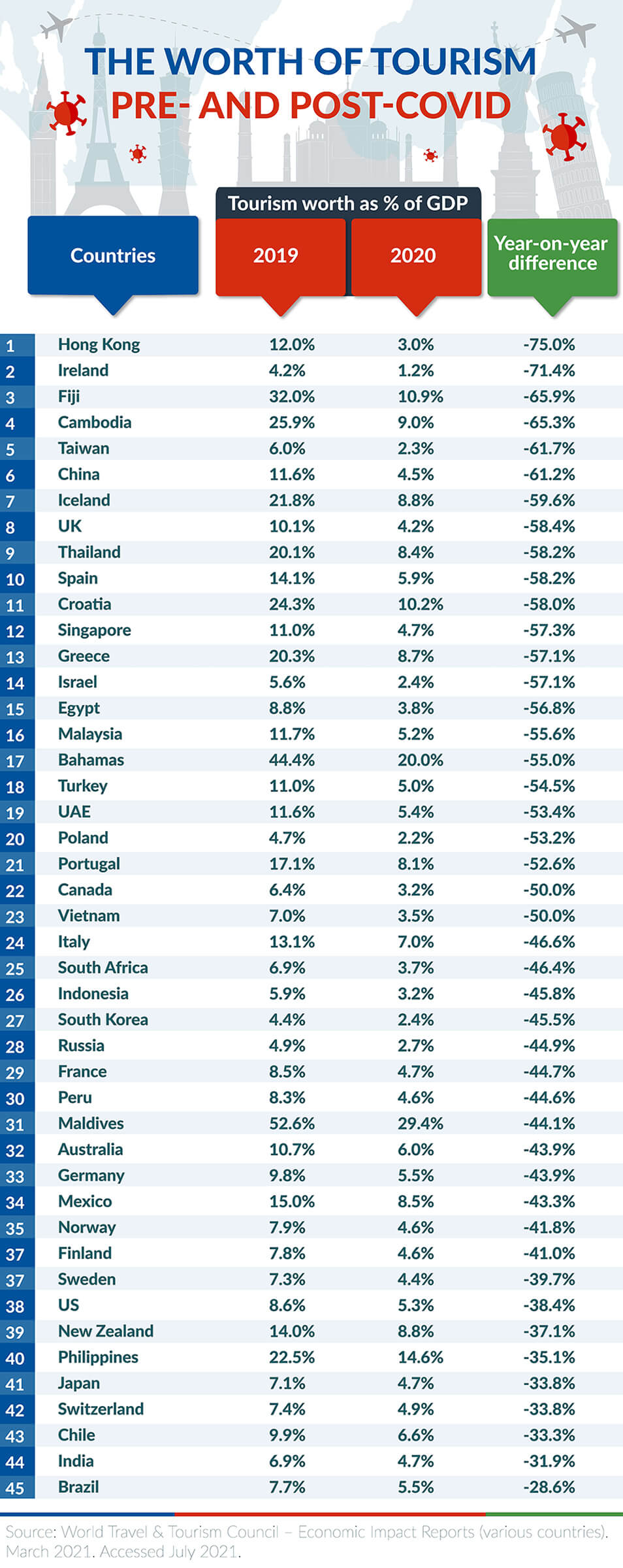The Burrow

The COVID-19 pandemic ravaged much of the world in 2020, impacting people, places and businesses. In particular, tourism has been one of the hardest-hit sectors as travel (both domestic and international) was brought to a grinding halt worldwide.
Naturally, this had an impact on how travel insurance and cruise travel insurance worked, as insurers had to adapt to ensure they provided varied types of cover for different travellers.
Some of the changes travel insurance saw as a result of the pandemic include:
Whatever you look for when purchasing a travel insurance policy, an important consideration is the Product Disclosure Statement (PDS), which you should read prior to purchasing any sort of cover. It will outline any restrictions, limits or exclusions, so that you know exactly what you may or may not be covered for in the event you’d like to make a claim.
To see just how else the tourism industry changed, the travel experts at Compare the Market analysed figures from the World Travel & Tourism Council (WTTC) to assess the worth of tourism from pre- to post-COVID. By comparing the contribution of tourism towards each country’s GDP in 2019 and 2020, we can see just how much the pandemic has impacted each nation’s tourism and economic sector.
Hong Kong’s tourism and travel GDP took the biggest hit between 2019 and 2020, out of a selection of 45 countries. According to the WTTC’s data, the contribution of tourism and travel to the city’s GDP dropped by a dramatic 75% from 12% in 2019 to just three per cent in 2020.
Unfortunately, there were losses seen across the board. Of the 45 countries included in our research, every single one presented a loss in the worth of their tourism industry year-on-year. It pains a morbid picture of the global travel industry that many nations hope to see improve as we emerge from the pandemic – particularly countries with a heavy reliance on tourism to stimulate the local economy.
Click through the tabs below to see the other countries most and least affected.
With major political protests and a global pandemic hitting the small island in 2019 and 2020, it’s no wonder that Hong Kong’s tourism sector has suffered as much as it has. In 2019, tourism and travel contributed US$45 billion to Hong Kong’s economy; in 2020, that figure dropped to just USD$10.6 billion.
Ireland was the second most affected country in our selection of 45, experiencing a drop from 4.2% of GDP generated by tourism in 2019 to just 1.2% in 2020 (an overall decrease of 71.4%). In dollar figures, the difference is even starker. Ireland raked in USD$17.5 billion in total from travel and tourism in 2019, but in 2020 only generated USD$5.1 billion.
Another island nation, Fiji, suffered a 65.9% decrease in tourism’s contribution to the country’s GDP. In 2019, tourism in Fiji amounted to 32% of the GDP, but by the end of 2020, that number tumbled to just 10.9%. It just scraped into the bottom three, beating Cambodia by less than half of a per cent.
Brazil was the least affected country in our list of 45. The contributions from the tourism and travel sectors to the country’s GDP decreased by 28.6% from 2019 to 2020 and dropped from USD$115.7 billion in 2019 to USD$78 billion in 2020.
For a country hit so hard by the COVID-19 pandemic, India’s tourism GDP was affected to a much lesser degree than other countries in the world. Contributions to GDP from travel and tourism dropped from 6.9% in 2019 to 4.7% in 2020, an overall decrease of 31.9%.
Out of the 45 countries we analysed, Chile came in at number 43 in terms of impact on tourism GDP. The South American country experienced a 33.3% drop in tourism contribution to the GDP from 2019 to 2020 as the pandemic took hold worldwide. Chile just barely made it into the top performing nations, by beating Switzerland by a marginal half of a per cent to land in the top three.

We consulted the Economic Impact Reports from the World Travel & Tourism Council (WTTC) for various countries, narrowing it down to 45 and ensuring representation from all continents. These reports include the “total contribution of travel and tourism to GDP” as a percentage figure of the country’s total economy for both 2019 and 2020.
We then used a spreadsheet formula to calculate the year-on-year difference between the 2019 and 2020 GDP figures as a percentage decrease.
Tourism worth as percentage of GDP and in USD
World Travel & Tourism Council – Economic Impact Reports (various countries). March 2021. Accessed July 2021.
Brought to you by Compare the Market: Making it easier for Australians to search for great deals on Travel Insurance.